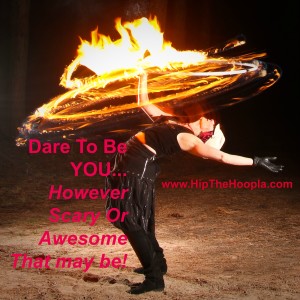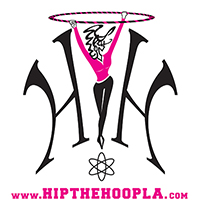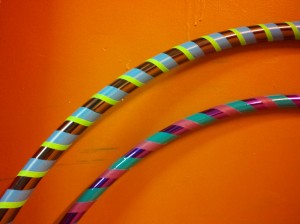Posts Tagged ‘Safety Information’
10 Fire Hooping Safety Tips & Tricks

Fire Hooping Safety for Smart People
So you want to set your hula hoop on fire and dance? Here’s some tips that will help you do that safely so you–and others–can enjoy the experience. Bonus short video demo at end!
1. ALWAYS have at least one Fire Safety.
A “Fire Safety” is a person who is watching you carefully and has proper training to calmly help alert and assist you in any situation and avert potential danger. Your fire safety should have a duvatene towel, cotton towel or wet large natural cloth to put out your fire props, you, or any area that starts on fire (if your prop hits the grass outside–try stepping on it immediately to put it out).
2. Get trained with experienced fire spinners who know what they are doing.
Their advice and experience can safe you a huge learning curve and keep you happy and healthy, too! They can also school you on different props, including pros and cons of different styles and companies. Do your own research too! The more you educate yourself in props, techniques and safety, the more well-prepared you will be for your “Virgin Burn” (first time fire spinning). **Get your fire props from a reputable source. They are NOT toys. Spend the money and get something good–or borrow from someone to try theirs out (with their permission and supervision).
3. Do not mix any mind-altering substances with fire.
Your judgement, timing and perception can turn something fun into something very bad-very quickly (including alcohol, legal or illegal drugs or even out of control emotional state–if you know you shouldn’t get behind the wheel of a car, then the same applies to working with fuel & flame).
4. Wear proper clothing.
Make sure your clothing is made of natural materials which have a lower burn rate (no synthetics–those can easily flame up AND melt TO your SKIN–bad burns & emergency room visits!) Also you want form fitting movable clothing (not super tight and nothing loose and flapping–like ribbons or dragging pant legs).
5. Keep your fueling area safe and away from anything that can ignite it.
It should be separate from the area you “burn”, “light up” or fire dance in. This means NO cigarettes, small children, drunk/stupid people, etc. Definitely start fire spinning OUTDOORS in an open, safe, clear area. Do NOT spin fire inside, unless you have experience AND FIRE INSURANCE. You can spin on private property without insurance. You need proper insurance and a permit to spin in public places. Many spin without, but you take on a lot of safety and financial risk to do that. Anyone who is a professional or performs/takes in money, should have these.
6. Use the proper fuel.
Just because you have a fuel–that burns, doesn’t mean it is a good idea to use it with your fire props. Some can have more toxic fumes, and other consequences that are not safe or pleasant. Most of the people I know, including myself prefer Coleman’s White Camping fuel. You can get it, reasonably priced, wherever you can get camping equipment or surplus supplies (like a military store).
7. Start small and try out a fire hoop (or fire prop) WITHOUT being lit up.
There is a different weight to get used to along with some different movements that you will find better to attempt before you try everything you know in hooping/flow spinning.
8. Protect your head and hands.
Some people wet their hair. Some wear a hat or scarf and tuck their hair up and in. I learned my lesson when my fire safety said, “Your hair is on fire,” during a parade. The tail end of my long braid caught and I got it out quickly before damage was done. Since then–I’m all for not having the nasty scent of burning hair. Also, do NOT use hairspray–unless you want to pull a “Buffy The Vampire” trick and ignite very easily! As for your hands, I like leather gloves. There are other gloves, sleeves and gauntlets you can use that are natural materials that are helpful or safe choices.
9. When you play with fire, you CAN get burned…it’s FIRE, after all!
Most of us fire spinners have an injury, burn or experience to tell you about where not everything went right. It happens. Fire is a risk. We do the best we can to minimize it with knowledge, practice, safety and experience. Make sure you check your fire props BEFORE you fuel up and light up-check that all is secure and in good condition/working order. Bad connections can come loose and start fires.
Also, make sure you squeeze out excess fuel (use rubber gloves) from your wicks, and/or “spin off” in a safe area (away from others) so that you do not fling flaming fuel at anyone or anything, once you are lit up.
10. Keep a first aid kit easily accessible.
Burn cream, clean dry bandages, Water, and cell phone. Prevention will help way more than not planning ahead to be safe. A bonus trick someone passed along to me was some essential oil (especially lavender oil), to help heal and is pleasant smelling for burned nose hairs! Really happy I know that one now!
Bonus: By being safe, you will have more fun!
Also know that…
*FYI: Fire is loud.
* Fire is awe-inspiring.
* Fire gets your adrenaline pumping.
Performers Bonus…Here’s an important fire tip for your fire spinning tricks:
Try to do faster moves in the beginning when your wicks are more fueled (waist, leg, chest hooping), and slower ones (isolations, floats, poses, etc) when your fuel is burning out and your flame is low. Fast moves will put out your fire out faster–slower moves will extend the life of your “burn”.
Here’s a video of the Colorado Fire Tribe Performing at the 9News Parade of Lights in Denver, Colorado. (Che’ Rippinger is the fire hooper with the black beret).
♥ Blessings & Happy Hooping Health! ♥
*********
~Che’ Rippinger is Hip The Hoopla‘s CHO (Chief Hooping Officer)/Owner/Founder and head humorist, with heart. She’s been hula hooping since 2008 and founded Hip The Hoopla in 2011 – while teaching, performing and making pro custom dance hula hoops. A dancer most of her life, Che’ has also been a humor writer/columnist, illustrator and cartoonist for The Denver Post and her Touché! Cartoons have been featured in PLAYGIRL Magazine.
Keep up with Hip the Hoopla with news, #Hoopspiration and special offers. Please sign up now for our special e-mails member list.
Also, please follow us on Facebook. We’re even on YouTube (with our own channel), Twitter, Pinterest, LinkedIn, Yelp, and Instagram. To contact us for group classes, private coaching, premium service packages, VIP days, events, performances or custom professional dance hoops, please call 303-980-6295, visit www.HipTheHoopla.com or e-mail Che@HipTheHoopla.com. (Please do not add us to call/e-mail lists without permission.)
Helpful Hints to get Leg Hooping
-
It took me a year of many try to explain it to me and trying to get “leg” hooping (some do call it “knee” hooping*–but I want to name things in the most positive, safest & most accurate light–according to my own style of teaching, extensive dance training, and opinion)…Here you go with some great tips from myself & a compilation of great teachers I’ve studied with to help you get it faster, better & safer:
- *Important Safety Note: in Hip The Hoopla class, I have hoopers hoop either above or below the knees, not actually on them–because many hoops, especially the bigger heavier beginner adult hoops, can really hurt tendons in that area and increase knee problems.
-
1. To heck with the right to bear arms…Bare Legs!
Wear shorts–sticky is better so skin works best. Otherwise have gaffer tape on your hoop…or at least sanding, if your hoop is plain. -
2. In a multi-hoops workshop, Luna Breeze finally brought it home in my thought process: use both legs & pulse them TOGETHER really fast. FYI: Get the fast pulse/beat going WITHOUT the hoop first. Your movement beat must be very steady (rhythmic tempo) and fast. Rule of thumb: waist hoop is a nice pace, hip hooping is a little faster, and thigh hooping is really moving.
-
3. When you do the leg beat together, you can move with the hoop–ie turn more easily.
-
4. It takes a lot of practice. I actually got one leg hooping way before two. (I manually started the hoop on one leg and just kept a beat.)
-
And Now….to get it back up…you’ve got to get your hips to bump up & up & up like a staccato shimmy (a useful belly dance move) so the hoop crawls back up the outside your legs & hips like rungs on a ladder. Now that is really helpful to do while Turning! (Remember turning in the rotational direction of your hoop is an exellent recovery method and helpful when learning new tricks…ie. the hoops rotations slow down, so you can catch up with it!)
 Happy Hooping Everyone~ From Ché Rippinger of Hip The Hoopla. Many years of dance experience, learning, teaching and growing. Helping you break down the hard stuff, step by step, with a sense of humor, Laughter Yoga, child-like play and hopefully having a wonderful learning experience.
Happy Hooping Everyone~ From Ché Rippinger of Hip The Hoopla. Many years of dance experience, learning, teaching and growing. Helping you break down the hard stuff, step by step, with a sense of humor, Laughter Yoga, child-like play and hopefully having a wonderful learning experience.
For more class information, private lessons, coaching, custom hoops, specials, news, events & booking performances, please contact 303-980-6295 or e-mail Che@HipTheHoopla.com. www.HipTheHoopla.com
Please find, follow and “like” us on Facebook.
Hip The Hoopla is also on Pinterest, Twitter, YouTube, Yelp, LinkedIn, etc!


